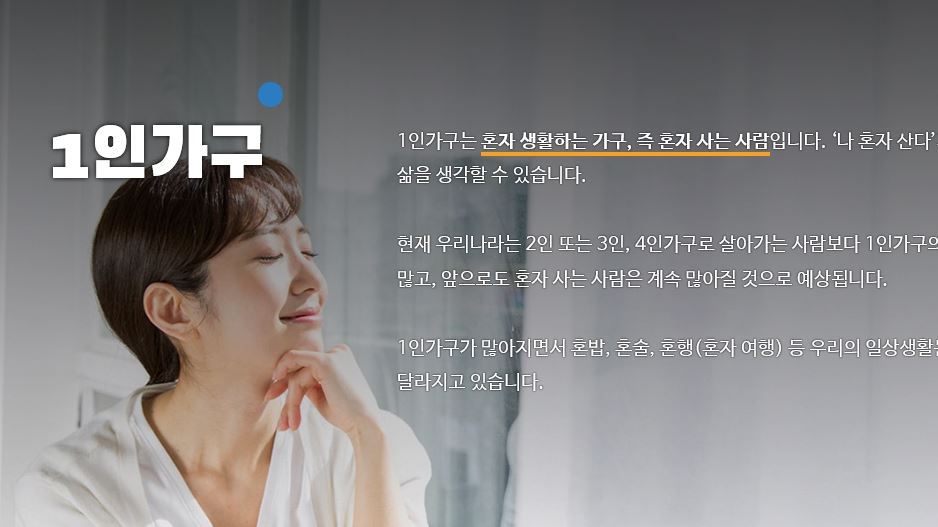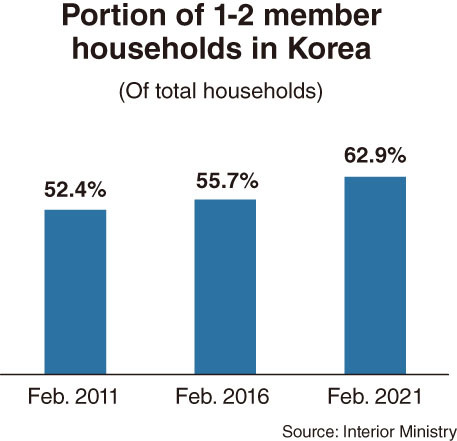[News Focus] Smaller households hit record high of 14.6 million
Single-person households make up nearly 40% in Korea
By Kim Yon-sePublished : March 21, 2021 - 16:58

SEJONG -- All-time low fertility rates have caused a surge in the number of two-member households in South Korea, alongside the sharp increase in the number of single-person households amid sliding marriage rates, official data showed.
According to the Ministry of Interior and Safety, the number of one- or two-member households reached a record high of 14.61 million (9.16 million and 5.44 million respectively), or 62.9 percent of the total 23.19 million households nationwide as of February.
This indicates that more than 3 out of every 5 Korean households consist of people residing alone or two people living together.
The figure climbed by 7.2 percentage points from 55.7 percent posted five years earlier in February 2016 and 10.5 percentage points from 52.4 percent in February 2011.
Looking at single-person households only, their proportion of the nationwide total marked a record high of 39.5 percent in February 2021, as compared with 34.5 percent for the corresponding month in 2016 and 33.2 percent in 2011.

This means nearly 2 in 5 Korean households were single-person households as of last month.
“The tally for Koreans living alone is increasing rapidly, as is the number of young couples without children,” said a demographer.
He said the growing portion of single-person households can also be attributed to a surge in the number of female seniors in the wake of their longer life span than men.
“Korea is posting low marriage rates, rising divorce rates and the world’s lowest fertility rates. This is changing the family-member structure,” he said.
Seoul and some major metropolitan cities, such as Busan and Daegu, face a growing portion of the young generation reluctant to get married in the wake of high unemployment rates and other uncertainties involving spiraling apartment prices.
In the 1980s and 1990s in Korea, four-member households were common, typically consisting of a couple and two children. But the situation has changed over the past decade.
Interior Ministry data showed that four-member households took up 21.2 percent (4.22 million) of all households across the country in February 2011.
They were the second most common type of household in proportion to the total, trailing single-person households, of which there were 6.61 million making up 33.2 percent of all households.
Ten years ago, two-member (19.1 percent) and three-member (18.4 percent) households represented the third and fourth most common structures.
On the contrary, the number of four-member households (3.48 million) made up only 15 percent last month. Its portion dropped from No. 2 to No. 4.
Data showed that four-member households were initially overtaken in number by two-member households in November 2013, when the former stood at 4.12 million and the latter at 4.13 million.
In addition, four-member households were overtaken by three-member households in February 2017, when the respective numbers posted 3.92 million and 3.93 million.
Like households with four residents, those with five dropped over the past 10 years -- from 1.19 million in February 2011 to 860,000 in February 2021.
Over the same period, the number of households with six people fell from 280,000 to 172,000. In contrast, in the 1960s and 1970s, it was very common for Korean grandparents to live with their grown children and grandchildren.
By Kim Yon-se (kys@heraldcorp.com)



![[Herald Interview] 'Amid aging population, Korea to invite more young professionals from overseas'](http://res.heraldm.com/phpwas/restmb_idxmake.php?idx=644&simg=/content/image/2024/04/24/20240424050844_0.jpg&u=20240424200058)












![[KH Explains] Korean shipbuilding stocks rally: Real growth or bubble?](http://res.heraldm.com/phpwas/restmb_idxmake.php?idx=652&simg=/content/image/2024/04/25/20240425050656_0.jpg&u=)

